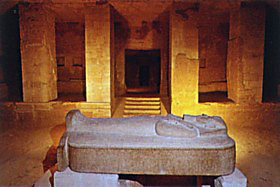Date: 7:30 – 9:00pm, 23-Nov-2012
Cost: Meetings are Free to members, Guests $5 – Students with ID $2
Description:
The tomb of the Nineteenth Dynasty pharaoh Merenptah is unique in having contained four stone sarcophagi as part of that ruler’s burial equipment. Three red granite boxes and lids, each of different shape and decreasing size, were set one within the other. The third or innermost of the granite sarcophagi held a fourth sarcophagus carved from travertine (“Egyptian alabaster”), which in turn, held the coffined and mummified remains of Merenptah.
After the tomb was robbed late in the Twentieth Dynasty, the priesthood of Amen in Thebes reburied the king’s remains in KV 35, the tomb of Amenhotep II. Eventually, a decision was made to re-use material from the abandoned burial equipment, particularly the stone sarcophagi. The boxes of the two outermost sarcophagi were broken up to extract the third sarcophagus for re-use in Tanis for the burial of Psusennes I of the Twenty-first Dynasty. Remains of the two smashed boxes as well as their intact lids were discovered by Howard Carter when he cleared the tomb of flood debris in 1903. Edwin Brock began an investigation of the sarcophagi remains in 1982 and subsequently found more fragments during clearance operations which he carried out in the tomb between 1987 and 1990. Recent clearance work in the tomb by a mission from the Louvre yielded more fragments of granite and some of travertine from the sarcophagi, as did excavations by the SCA outside the tomb.
From March 2011 to May 2012 a project affiliated with the Royal Ontario Museum in Toronto was carried out to document and reconstruct the outer sarcophagus box of Merenptah. Although only one-third of the original first sarcophagus box remained in fragments it was still possible to reconstruct the appearance of the original monument. Outlines of the missing decoration were added to the infill of the gaps to form a visual bridge between the reassembled fragment groups. The cartouche-shaped second lid was moved from its previous position in the center of the chamber and re-positioned on metal supports. The lid for the first sarcophagus box was found by Carter in the antechamber above the burial chamber, where it had been deposited by workers recycling the burial equipment. This was also raised onto metal supports and mirrors were placed beneath both lids so that visitors might better view the decoration on the hollowed undersides.
This presentation will illustrate the various phases of the project, including the moving of the second sarcophagus lid, hauling massive stone blocks up the hillside to the tomb entrance to be lowered into the burial chamber, and the installation of the massive groups of reassembled fragments of the outer box. It will show evidence for the method of lowering the massive granite sarcophagi into the tomb and how the sarcophagi were later destroyed.
About the speaker:
Edwin Brock has worked nearly thirty years in Egypt After completing studies at the University of Toronto, he served ten years in Egypt as director of the Canadian Institute in Egypt. He served as staff Egyptologist for five years with the Theban Mapping Project, worked as archaeological consultant with the American Research Center’s Valley of the Kings Flood Protection Project and as archaeological monitor for two USAID-funded engineering projects in the areas around Karnak and Luxor temples for sewerage installation and lowering ground water. He has worked extensively in the Valley of the Kings, including carrying out a reconstruction of one of the sarcophagi of Ramesses VI. Outside of Luxor he has worked on archaeological projects in the Dakhlah Oasis, at Memphis and in the eastern Delta.
Location:
Room EDC 287 in the Education Block at the University of Calgary.

